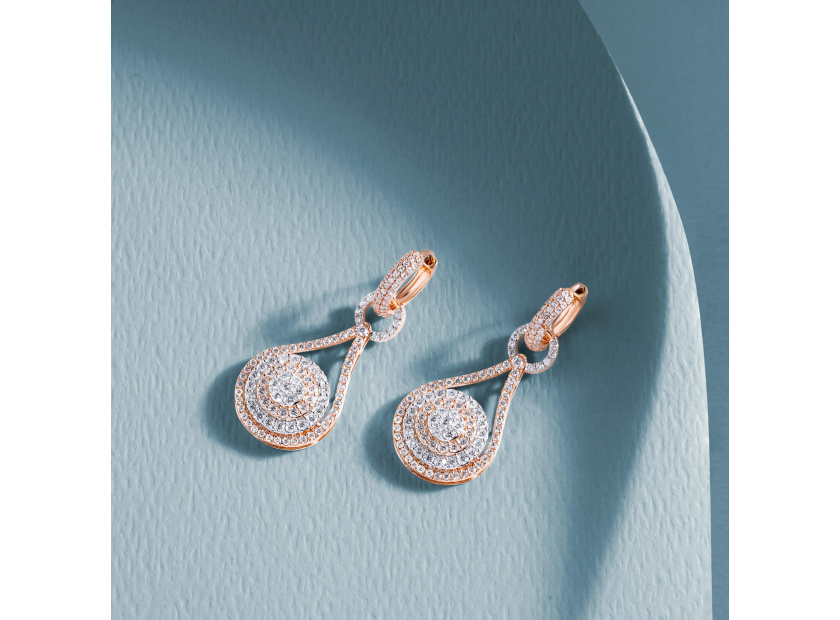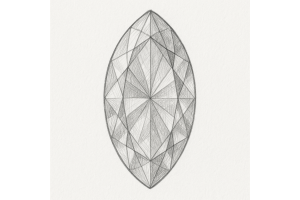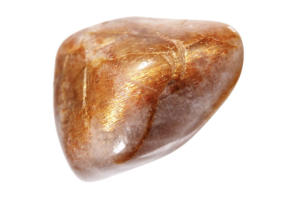GBP
/
GBP
/
Shipping to:
Currency:
How to Tell If a Diamond is Lab-Grown vs Mined: Expert Guide
Diamonds are dazzling treasures, and whether they’re lab-grown or mined, they hold an undeniable allure.
Yet, as lab-grown diamonds rise in popularity, many wonder—how can you tell the difference between these and their mined counterparts?
In this guide, we’ll walk you through everything you need to know to distinguish between lab-grown and mined diamonds, from the subtle physical differences to the tools that gemologists use.
So, if you’re on the hunt for that perfect diamond or simply curious, read on to become a diamond detective.
What Are Lab-Grown Diamonds?
Lab-grown diamonds, also known as synthetic diamonds, are created in a laboratory using cutting-edge technology that mimics the natural diamond formation process.
Unlike simulants like cubic zirconia, lab-grown diamonds have the same chemical and physical properties as natural diamonds.
There are two main methods to create these diamonds: Chemical Vapour Deposition (CVD) and High-Pressure High-Temperature (HPHT).
In the CVD process, carbon gas is broken down and deposited onto a diamond seed to grow the crystal, layer by layer.
HPHT, on the other hand, mimics the extreme heat and pressure found deep within the earth to form the diamond.
The result? A diamond that’s virtually identical to one that has been mined from the earth.
But, despite being so similar, there are a few subtle differences that can help you spot which is which.
If you’re interested in learning more about the technology behind lab diamonds, you can check out lab-grown diamonds.
The Main Differences Between Lab-Grown and Mined Diamonds
At first glance, lab-grown and mined diamonds look remarkably alike.
Both are made of pure carbon and have the same optical properties, meaning they reflect light in exactly the same way.
However, there are some key differences to be aware of.
Inclusions: Natural diamonds often have tiny imperfections known as inclusions—these might be small bits of other minerals or irregularities in the diamond’s structure.
Lab-grown diamonds, while not flawless, tend to have different kinds of inclusions.
For example, in HPHT diamonds, you might find tiny bits of metal trapped inside, as they’re created in a metal chamber.
These inclusions can sometimes be spotted under a microscope.
Growth Patterns: Mined diamonds often show unique growth patterns, formed over millions of years under the earth’s surface.
Lab-grown diamonds can also have growth marks, but they tend to be straighter, due to the controlled environment they’re made in.
Fluorescence: Some diamonds—both lab-grown and mined—exhibit fluorescence when exposed to UV light.
However, lab-grown diamonds are more likely to show a stronger fluorescence, which may give them a slightly different look under certain lighting conditions.
To explore more diamond options, you can check out our selection of fancy coloured diamonds.
How to Tell If a Diamond is Lab-Grown: Physical Characteristics
While lab-grown and mined diamonds are incredibly similar, there are a few physical characteristics that can help you tell the difference.
Inclusions: As mentioned earlier, the inclusions in a diamond can offer clues about its origin.
Lab-grown diamonds might have metallic inclusions from the HPHT process, whereas natural diamonds usually have mineral inclusions.
Graining: Natural diamonds often show graining, which is essentially lines that form as the diamond crystal grows.
Lab-grown diamonds can also show graining, but these patterns tend to be more regular and uniform.
Fluorescence: As a general rule, lab-grown diamonds tend to have stronger fluorescence when exposed to UV light.
If you’re unsure about the origin of a diamond, exposing it to UV light might give you a clue.
For those interested in particular shapes, you can check out our range of pear lab-grown diamonds.
Using Professional Tools to Identify Lab-Grown Diamonds
While the naked eye might struggle to spot the differences, gemologists have a range of tools that can help determine whether a diamond is lab-grown or mined.
Diamond Testers: Traditional diamond testers can distinguish between diamonds and simulants like moissanite or cubic zirconia.
However, they can’t differentiate between lab-grown and mined diamonds since both have the same thermal and electrical properties.
Spectroscopy: One of the most effective ways to tell if a diamond is lab-grown is through spectroscopy.
This advanced tool analyses the way light passes through the diamond, revealing patterns that can indicate its origin.
Lab-grown diamonds often display distinct patterns due to the way they are created.
UV Light Tests: Lab-grown diamonds typically have a stronger fluorescence when exposed to UV light, especially CVD diamonds.
This can be a quick way to spot a lab-grown gem, though it’s not foolproof.
Laser Inscription: Many lab-grown diamonds are laser-inscribed at the girdle with a code that indicates they are lab-grown.
These inscriptions can usually only be seen under magnification but are a clear indicator.
For more on sourcing the perfect diamond, check out our selection of round lab-grown diamonds.
Lab-Grown Diamond Certification vs Mined Diamond Certification
Whether lab-grown or mined, a diamond should always come with a certification from a reputable gem lab.
This certification will confirm the diamond’s carat, cut, colour, clarity, and—importantly—its origin.
The most well-known labs that certify lab-grown diamonds include the Gemological Institute of America (GIA), International Gemological Institute (IGI), and the American Gem Society (AGS).
These certifications will clearly state whether the diamond is natural or lab-grown, giving you peace of mind about what you’re buying.
If you’re looking for diamonds with certifications, check out our cushion lab-grown diamond selection.
Price Differences: An Indicator of Origin?
One of the more obvious differences between lab-grown and mined diamonds is their price.
Lab-grown diamonds tend to be 30-40% cheaper than mined diamonds of similar quality.
This is largely due to the lower production costs and the fact that lab-grown diamonds don’t have the same scarcity as mined diamonds.
However, price alone isn’t always a reliable indicator.
While a lower price can suggest that a diamond is lab-grown, there are still high-quality, expensive lab-grown diamonds that might rival the price of a mined diamond.
The key is to look for a certification that clearly states the diamond’s origin.
For affordable options, you can check out our radiant lab-grown diamonds.
Ethical and Environmental Impacts: Mined vs Lab-Grown
For many, the ethical and environmental impacts of their diamond purchase are a big part of the decision-making process.
Environmental Impact: Lab-grown diamonds are often touted as the more environmentally friendly option because they don’t involve mining, which can cause significant ecological damage.
However, lab-grown diamonds do require a lot of energy to produce, especially those made using the HPHT method.
Ethical Considerations: The mining industry has long been associated with ethical issues, including poor working conditions and the funding of conflict (so-called “blood diamonds”).
By contrast, lab-grown diamonds can offer a more ethical alternative, free from these concerns.
If you’re interested in ethical diamond options, check out our heart lab-grown diamonds.
Common Myths and Misconceptions About Lab-Grown Diamonds
There are plenty of myths surrounding lab-grown diamonds, and it’s time to set the record straight.
Myth: Lab-grown diamonds are fake.
Fact: Lab-grown diamonds are real diamonds, with the same chemical and physical properties as mined diamonds.
Myth: Lab-grown diamonds don’t have resale value.
Fact: While lab-grown diamonds may not hold their value as well as mined diamonds, they do still have resale value.
Myth: Lab-grown diamonds are flawless.
Fact: Lab-grown diamonds can have inclusions and imperfections, just like natural diamonds.
For more clarity, check out our selection of emerald lab-grown diamonds.
Conclusion: Making an Informed Choice Between Lab-Grown and Mined Diamonds
At the end of the day, lab-grown and mined diamonds are both stunning options, and the choice between them comes down to personal preference, budget, and values.
By understanding the subtle differences and knowing what to look for, you can make an informed decision and find the perfect diamond for you.
FAQs About Lab-Grown vs Mined Diamonds
Can you tell a lab-grown diamond apart from a mined one by sight alone?
No, lab-grown and mined diamonds look virtually identical to the naked eye. You’ll need specialised tools or a gemologist to tell them apart.
Do lab-grown diamonds last as long as mined diamonds?
Yes, lab-grown diamonds are just as durable as mined diamonds and will last forever with proper care.
Are lab-grown diamonds worth the investment?
Lab-grown diamonds tend to be more affordable, but they may not hold their value as well as mined diamonds. However, they are an ethical and sustainable choice for many.
How do lab-grown diamonds affect the diamond industry?
Lab-grown diamonds are disrupting the traditional diamond market by offering a more affordable and ethical alternative. However, the demand for mined diamonds remains strong, particularly for those seeking rarity.









